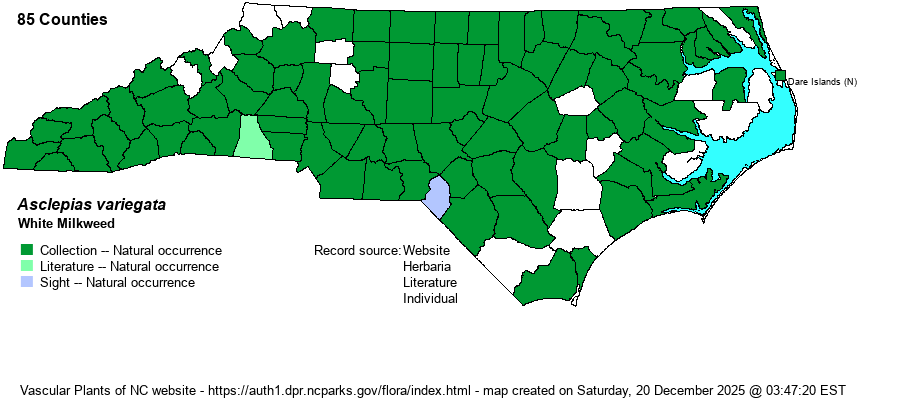| Author | L. | |
| Distribution | Occurs statewide, perhaps found in all counties, but of spotty occurrence in the lower Coastal Plain and the northern Mountains.
This is an Eastern species, ranging north to CT and southeastern MO, and south to northern FL and eastern TX. | |
| Abundance | Frequent to common over the Mountains, Piedmont, and most of the Coastal Plain; infrequent in the lower Coastal Plain, toward the coast. Next to A. tuberosa, this is our most widespread milkweed in the state. | |
| Habitat | This is a species of dry to dry-mesic soils, in partial shade. It favors open upland hardwood forests, woodland margins, glades, and some mixed pine-hardwood stands, though not normally in Longleaf Pine (Pinus palustris) sandhills communities. |
| Phenology | Blooms in May and June, and fruits from July to September. | |
| Identification | This is a fairly standard milkweed in size and leaf shape, having a single unbranched stem, reaching about 2 feet tall on average. It has about 3-5 pairs of opposite leaves, being widely elliptic to nearly oblong, about 4 inches long and about 2-2.5 inches wide. The flower cluster (umbel) is either solitary at the stem tip or one or two others from upper leaf axils. The clusters are densely flowered, rounded, and about 1.5-2 inches across, with the flowers bright white but with a purple band around the center of each flower (not seen at much distance). When in bloom, this species often "glows in the dark", if present in full shade of an upland forest. Even when not in bloom, a careful observer can identify the species by its few pairs of rather broadly rounded opposite leaves; if in doubt, pick a leaf at its base and see if it has the white, milky sap found in most members of the family. This species does not grow in colonies, but instead just singly or as scattered individuals. But, it is widespread enough on the landscape that a biologist should encounter it fairly often in field work in upland forests. | |
| Taxonomic Comments | None
| |
| Other Common Name(s) | Redring Milkweed, Variegated Milkweed | |
| State Rank | S5 | |
| Global Rank | G5 | |
| State Status | | |
| US Status | | |
| USACE-agcp | FACU link |
| USACE-emp | FACU link |

